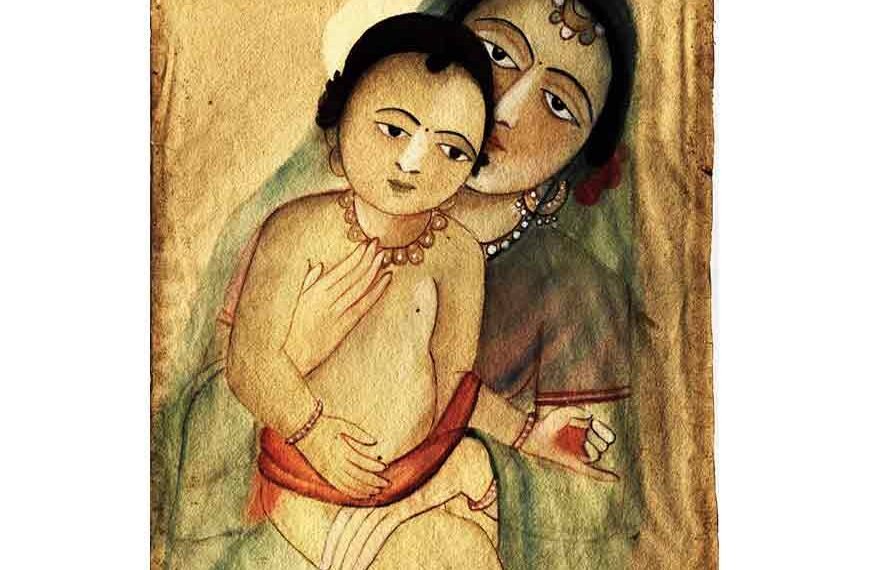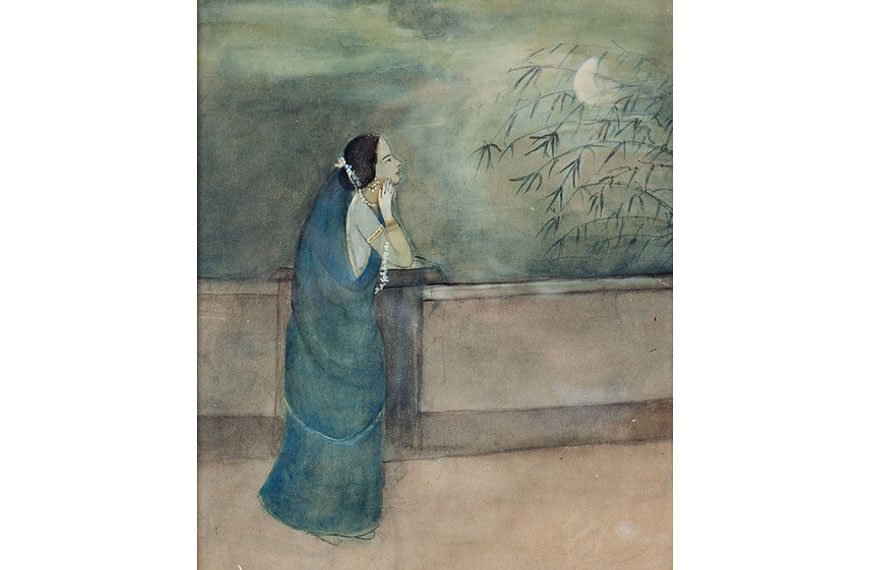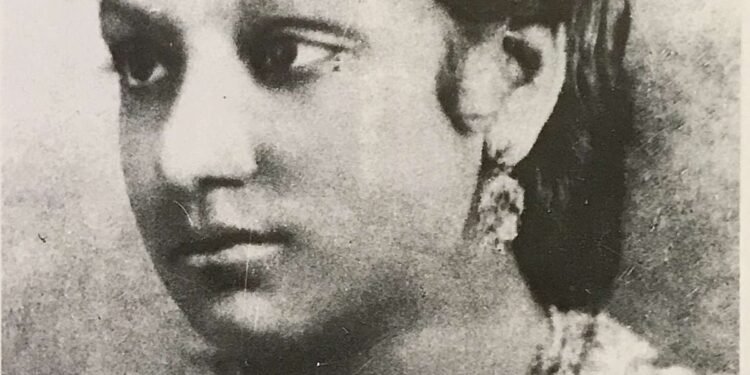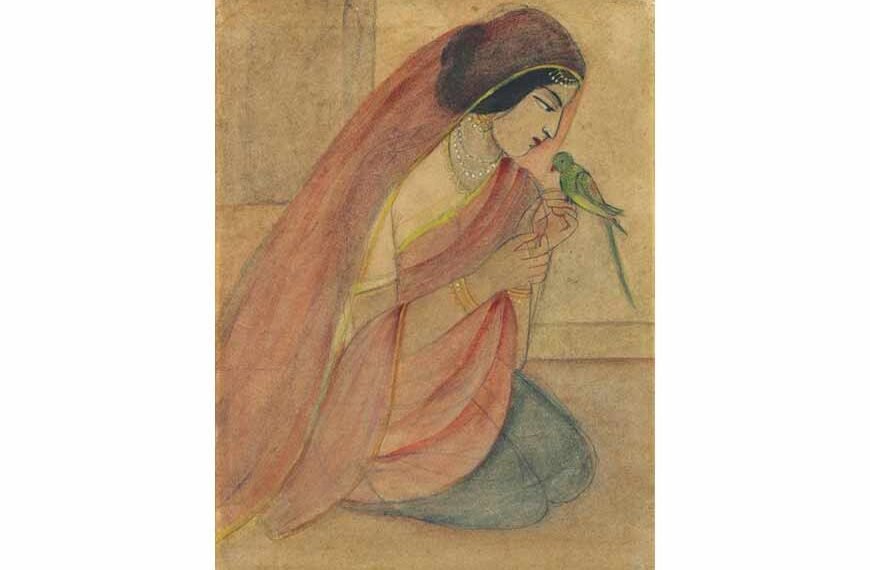Introduction
Sunayani Devi (1875–1962) stands out as one of the earliest modern Indian women painters, a self‑taught artist from the Tagore household whose “naïve‑primitivist” watercolours drew on Kalighat pat and village folk idioms to give intimate, woman‑centred visions of myth, devotion, and everyday life. Working largely within domestic constraints, she fashioned a distinctive style—soft washes, flowing line, flattened space, iconic eyes—that secured exhibitions in Calcutta and abroad and placed a female gaze within the Bengal School’s nationalist modernism.

Family, beginnings, influence
Born into the culturally formative Tagore family of Jorasanko, Sunayani was younger sister to Abanindranath and Gaganendranath Tagore and niece to Rabindranath, absorbing art by observation rather than academic training. Married in youth to Rajanimohan Chattopadhyaya, grandson of Raja Rammohun Roy, she began painting seriously around age thirty, encouraged by family support despite the era’s patriarchal limits. Her early visual world included devotional pictures, Ravi Varma oleographs, Rajput miniatures, and Bengal pata paintings, which seeded an idiom at once rooted and personal.
Style and motifs
Folk modernism: Critics place her as a “primitive” of the Bengal School, synthesizing Kalighat pat simplifications—bold contour, planar colour, sparse background—with a lyrical wash technique that recalls miniature and mural traditions.
The eye as icon: She evolved typologies of eyes—half‑closed introspective divinity; elongated fish‑shapes for heroines; deer‑like softness for lovers—encoding mood and status through stylized gazes.
Women and bhakti: Her Radha–Krishna studies, votaresses, mothers, milkmaids, and village maids centre feminine devotion, work, and interiority, projecting a woman’s subjectivity into canonical mythic scenes.
Notable works
Titled works attributed to her mature phase include Sadhika (female ascetic), Ardhanarisvara (androgynous Shiva), Satir Dehatyag, Milk Maids, and Yashoda and Krishna; each compresses narrative into emblematic poise, line, and hue, privileging expression over anatomical verisimilitude. The often‑cited Krishna Consorting Radha in a Guise of a Gopi distils playful intimacy through flattened forms and mesmeric eyes, typical of her devotional poetics.

Method and materiality
Sunayani preferred watercolour and the wash method, letting pigment breathe across paper for a soft, luminous surface; details remain minimal, ornament restrained, line rhythmic—producing an effect Stella Kramrisch praised as “naïve grandeur.” The childlike clarity is deliberate: a modernist primitivism that rejects academic naturalism for an indigenous, affective immediacy.
Place in the Bengal School
While Abanindranath theorized an Indian revival aesthetic and Gaganendranath experimented with caricature and later cubist inflections, Sunayani’s contribution was to translate folk‑pata intuition into a gentler devotional modernism, aligned with Swadeshi yet distinctly feminine. She exemplified a critical Bengal School tendency: turning to village idioms, Kalighat, and manuscript miniature for a nationalist visual language that could resist colonial academic canons.
Exhibitions and recognition
Sunayani’s work entered exhibitions of the Indian Society of Oriental Art from 1908 onward, showing in Calcutta, Allahabad, London, and U.S. venues, and featured in the 1922 Bauhaus‑linked exhibition in Calcutta—an early transnational moment situating her alongside European avant‑gardes. Collections like the National Gallery of Modern Art and the Indian Museum later affirmed her importance, while art historians have traced her influence on artists such as Jamini Roy in popularising folk‑rooted modernism.
A woman’s voice: thematics and gaze
Domestic sanctum to public art: Painting from within household rhythms, she reframed myth and devotion through the everyday lifeworld of women, making mothers, votaresses, and village actors carriers of bhakti and rasa.
The female gaze: Her protagonists—Radha, village maids, “The Votress,” “Mother”—hold the viewer’s eye as subjects rather than objects, an inversion that critics identify as an emergent woman’s viewpoint within early modern Indian art.
Quiet resistance: By privileging folk idiom and women’s interiority over colonial realism and male heroics, her practice becomes a cultural politics of softness—assertive in choice of sources, subjects, and style.
Comparisons and continuities
In contrast to Amrita Sher‑Gil’s later European‑trained modernism, Sunayani’s autodidact primitivism offered a complementary path to modernity via indigenous aesthetics and bhakti narrative. Her example—self‑taught, domestically embedded, yet publicly exhibited—opened conceptual space for women artists to claim modernist agency outside academic routes, anticipating mid‑century expansions of women’s professional art practice.
Legacy and afterlives
Canon position: Recent scholarship and curated overviews reassert her as a pioneering woman modernist whose fifteen‑odd years of focused practice seeded a durable folk‑modern synthesis.
Influence vectors: The Kalighat‑miniature vocabulary she adapted helped legitimate folk and “vernacular” sources as modernist resources, with downstream effects on Jamini Roy and subsequent craft‑centric modernisms.
Public memory: Renewed digital access—museum pages, Google Arts & Culture assets, and research portals—has widened visibility for key works and biographical context, encouraging reassessment beyond Tagore‑family footnote status.
How to view her art
Look for line and gaze: Attend to the calligraphic contour and the eye‑typologies; emotion is carried by eyelids, profile, and sparse gesture rather than by realist modelling.
Read the wash: Her colour breathes; background minimalism frames figures as icons, inviting contemplation in the manner of folk shrine pictures and Kalighat pats.
Track the folk cues: Jewellery, textiles, and simplified props signal sources and settings; the “rural” is aesthetic choice, not lack, articulating Swadeshi intimacy and cultural rootedness.
Conclusion
Sunayani Devi stitched a woman’s interior world to a nationalist visual language, proving that modernism in India could arise from the folk eye and domestic sanctum as surely as from studio and school. Her soft washes, iconic gazes, and pared‑down forms crafted a devotional modernity that centred women, sanctified everydayness, and helped tilt Indian painting toward indigenous sources with cosmopolitan confidence.





